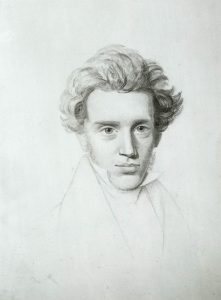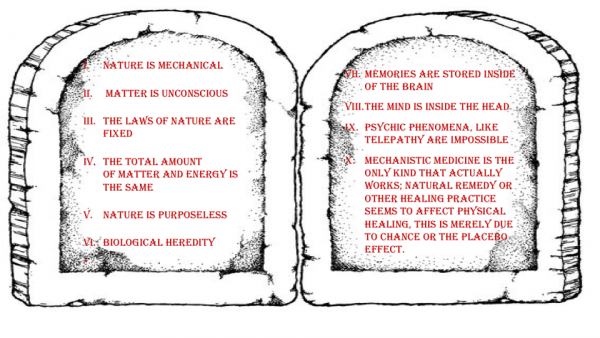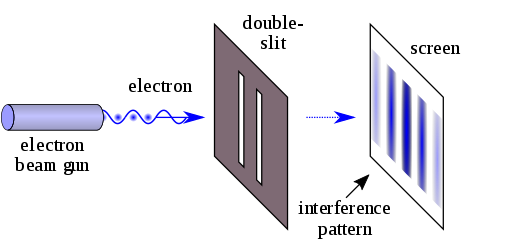Leap Into Faith
Eleanor: Kierkegaard, baby! Leap of faith.
Michael: It’s better translated as a “leap into faith.”
—The Good Place, Season 2, Episode 9
I believe in belief.
What does that mean? It’s very simple, really, and quite complicated at the same time.
Each of us carries with us at every moment of every day a model of the reality in which we engage. We each have very different sets of capabilities, experiences, and perceptions. From the first moment you came to consciousness — that certain moment when you realized ‘I am’ — you have spent your entire life processing and creating your understanding of the world. From a Data Science perspective, you have been creating a model of the universe in which you live. Much of it came from books, from education, from films and television and simply day to day living. All of it came from your life experience.

My model as yours yields the world view, or belief system, which you employ as we engage reality. Reality — that flow of stuff that is apparently outside our day to day thinking activities — is different for each of us. We can often agree, and often disagree as to the nature, content, and meaning of reality. But for all of us, no matter our station in life, no matter our profession or education, conduct our lives and think our thoughts inevitably bound to that model we have created. It is true by definition. I see what I see. Even if we are looking at the same picture, we are, by definition, seeing different pictures: I ‘see’ the reflection of ‘reality’ in my mind, scattered amongst my neurons and synapses and glial cells, just as you do the same with your mind.. I see what I see. You see what you see. And we all see selectively through filters of belief. In other words, my model of the world is necessarily used to process the information from the picture I perceive. And the model I can never escape is the essence of my system of belief. The same is true for every living human being.
So, belief. If everything I observe is fundamentally filtered through my internal model — the summation of my beliefs — what does that say about the scientific method? What does that say about ANY world view? What does that say about our universe? Let’s stipulate that there does exist a reality outside of your mind and mine that is, for lack of a better word, ‘real.’ That reality we agree upon, and begs the question of solipsism. For the sake of discussion, let’s agree that I am not the only conscious creature in the universe, nor are you. We then agree that there is ‘something’ outside our minds and we call that something the universe. To continue our discussion, let us also agree that we live in the same universe, regardless of internal models that we maintain. Now what? How do we explore this universe together, such as to continue to agree, given the inevitable divergence inherent in our internal models?
Three Bacons and a Descartes
Since the Enlightenment in Western Civilization we have explored the universe using science. Although we might credit Ancient Greeks like Aristotle or Epicurus, or 11th century Muslims like Al-Biruni, for origin we can point to the Western methods of scientific inquiry which were pioneered by thinkers like Roger Bacon, and Francis Bacon, and Rene Descartes. For Network Age inquiry adjustments, along with Sir Isaac Newton and Galileo, let’s add Stephan Wolfram to the list for his complexity insights in A New Kind of Science. And for fun, Kevin Bacon, for Six Degrees of Kevin Bacon influences.
Aside from Kevin and Wolfram, the simple version of the scientific method has a seemingly simple flow, and may also harbor a few serious flaws in light of the suppositions made here regarding models and beliefs. The simple scientific method description includes the following phases:

- Observations in the natural world lead to …
- Questions which lead to …
- Hypotheses, many of which can be tested through controlled …
- Experimentation the results of which are subject to …
- Analysis, allowing hypotheses to be verified or falsified leading to …
- Conclusions
Given earlier the assertion regarding personal models, my observations are mine. I see what I see. You see what you see. It follows that observation, colored as it is by my own unique and limited set of filters, cannot be exactly the same as your observation. A foundational reliance on observation therefore necessarily constrains and limits the methods we use to ascertain scientific facts. Questions that arise from flawed observations may then also be flawed. The hypotheses, the ‘ergo’ in Descartes famous edict, too is a function of belief. Ergo requires a presupposed system of thought — a belief system — one based on Aristotelian logic.
Mathematics is oft cited as perhaps the single transcendent truth we know. Is mathematics reality or does it transcend reality? Part of the universe or beyond the universe? Discovered or invented? You see, mathematics is foundational layer in the science belief system. We rely on measurement, calculation, and extrapolation based on mathematical assumptions or beliefs which we imbue on our experiments. We are obliged to accept mathematics as transcendent and the bedrock upon which our cathedral of science is built. Yet, we cannot satisfactorily answer the simple questions asked in this paragraph.
All this is to say that proponents of science-only approaches to understanding the universe must also rely on a set of foundational beliefs. Rupert Sheldrake does a fine job of questioning scientific dogma in The Science Delusion. You surely realize that even questioning any of these 10 commandments, as it were, is a form of heresy in some quarters. But really? Just take the placebo effect from number X in the dogma list as an example. Okay, we can’t really explain why it happens, but we observe it on a regular basis. Since we cannot explain it — the fact that some people believe something and are healed in the process — we label it as ‘placebo’ and simply move on, our dogma and assumptions still intact. If you’re not familiar with Sheldrake’s work, please open your mind and drink from that source. Understand how the 10 Dogma of Science seriously constrain our progress. He even equates presupposed scientific dogma as just another unequivocal religion.
The Dogma of Science
Given Sheldrake’s assertions, there is effectively no difference between the Bible-thumping preacher who insists on a literal acceptance of King James as the only truth, and the atheistic science-thumping reductionist who would deny the existence of anything not grounded in their understanding of a standard model of physics. Both extremes rely upon and insist that others accept their world view; the belief system upon which their logic is founded.
Some would argue for a moral high ground. “Where are the fruits of invention from your religious beliefs? Where are the verifiable experimental results?”, the science apologist may ask. To which the believer replies, “What are your ethics based on if not my discoveries by and assertions of my faith?”

Beyond school yard arguments for existence and creation, the implications of belief, as a key property of reality creation, profoundly impacts every perception, every observation, and every choice we make. This is true for every individual. And the collections of those beliefs in the aggregate are true for every civilization.
None of this to say there is no value in science, nor any reason to abandon religion. Obviously there is tremendous value in science. But it should be equally clear that the benefits of faith, in the aggregate, are just as profound. The histories of all civilizations our species may have birthed are written in the margins of faith-based tomes.
I see what I see. You see what you see. We create our universe with and in our thoughts. Of course we can establish agreements at some level regarding the nature of objective reality — the very reality that is demonstrably true whether we believe it or not. Clearly we can. Earlier we agreed we would. But it cannot be said that my understanding of objective reality is exactly the same as yours. My belief in the nature of objective reality is very likely very different from yours. Our interpretation of reality may be just as divergent. The fact is, when it comes to our collective understanding of the universe based on science, we simply cannot explain a litany of observations based on accepted natural theories. Among these are the very nature of the universe itself. Physics is not certain. The deeper we dive into physics, the stranger the mechanics become. And we keep discovering new particles and forces, from atoms to quarks, that drive our bodies, our brains, and our universe. In light of new observations, theories are updated with interpretations stretched to the point of absurdity at times. It is entirely possible that the universe is made up of dozens or thousands of dimensions we will never be able to experience nor measure in any direct manner. To that extent, objective reality is an abstraction we may never quite pin down — at least not with colors only from the reductionists palette.
The existential abstraction in which we reside, a universe we will likely never fully grasp nor agree upon as an objective reality, is only the model we create with our thoughts. It is consciousness that fills in the gaps, as it were. Human consciousness. I, for one, believe we have not yet scratched the surface of what this amazing gift of consciousness can yield. Perhaps you familiar with the work of Dean Radin.
Quantum woo
With thought alone, can I influence objective reality?
Dean Radin and others say yes. Independent verification of Radin’s modification of the double-slit experiment testing if human thought can indeed change quantum outcomes have concluded that a modestly (statistically) significant psychophysical interaction can be detected.

In modern physics, the double-slit experiment is a demonstration that light and matter can display characteristics of both classically defined waves and particles; moreover, it displays the fundamentally probabilistic nature of quantum mechanical phenomena.
The implications are enormous. It means that consciousness is not entirely constrained by nor subject to known physical laws. It means the mechanical views of reality we have embraced since Newton are woefully incomplete. It means our understanding of the quantum world may yet have implications beyond which we cannot explain with the Bohr-Heisenberg Copenhagen Interpretation. And it also means that belief can shape the reality that cloaks it. And also, now we are fully into the realm of quantum woo, which, along with Sheldrake’s dogma, serves to marginalize those who would be more open to explorations outside of sanctioned orthodoxy. The truth is, interpretations of quantum reality is all woo at some point. Even the more orthodox view. To avoid discussion of a creation from intelligence, are parallel universes not woo? Are 11 dimensions not woo? Everything connected to everything, or the everything-is-hologram, or panpsychism not woo?
Both science and faith can meet at the intersection of Kierkegaard and Heisenberg with a full-throated defense of their own explanation for existence, neither of which are fully congruent nor complete. But perhaps together, we might then better explain our universe and choose ourselves into meaning with both sides at the table.
If nothing else, the Dean Radin experiments should be taken seriously, replicated again and again, with as much funding as humanly possible. Would DARPA not be interested in minds controlling matter? Wouldn’t that set of super-powers be worthy of investment?
I believe in belief. Belief, as a manifestation and expression of human consciousness, quantum-entangled to everything I perceive. Belief is the leap into faith we all make, no matter our belief system. Belief is both the lever and the place to stand. And with that, perhaps we can actually move the world.
Leave a Reply